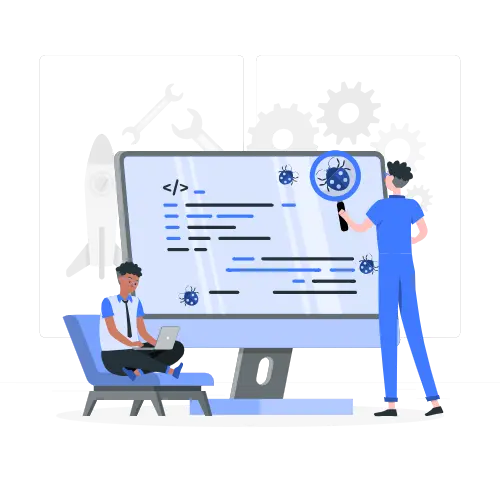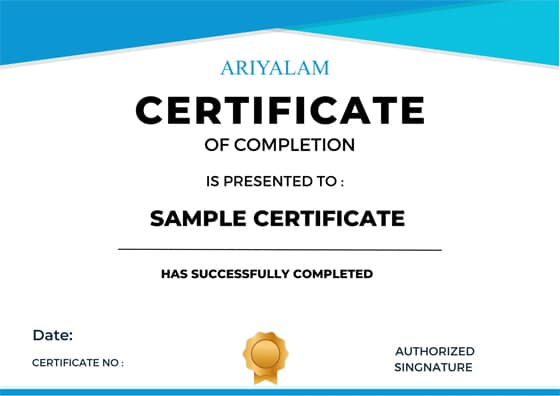Software Testing Course Online
Our Software Testing course online provides comprehensive training on master manual and automation testing processes. Designed for beginners and professionals, it covers essential concepts like test planning, execution, defect tracking, and popular tools like Selenium and JIRA. With a focus on hands-on projects and real-world scenarios, this course equips students with the skills to ensure software quality, enhance product performance, and improve user experience.

Software Testing Course Fees
Key Features
Software Testing Certification

Key Features
Software Testing Certification

Software Testing Course Online Prerequisites:
The prerequisites for a Software Testing course online vary but generally include a basic understanding of computer science fundamentals, familiarity with programming languages like Java or Python, and some knowledge of software development processes. Analytical skills, attention to detail, and an understanding of software lifecycle models, such as Agile or Waterfall, are also beneficial.
Join our software testing course Online to learn manual and automation techniques, perfect for beginners and experienced professionals.
Software Testing Course Syllabus
Manual Testing Course
- Introduction to Testing
- What is software testing?
- Importance of testing in software development
- Overview of manual testing
- Verification vs Validation: Key differences and their importance
- Types of Applications
- Web applications
- Mobile applications
- Desktop applications
- Cloud-based applications
- Common Sources of Errors in Applications
- Why errors occur during development
- Examples of common software bugs
- Software Development Life Cycle (SDLC)
- Overview of SDLC and its stages
- Development Models:
- Waterfall
- Prototype
- Spiral
- Incremental (including Agile methodology and Scrum Framework)
- V-Model (Verification and Validation Model)
- Advantages and disadvantages of each model
- Principles of Testing
- Core principles of software testing
- Software Testing Life Cycle (STLC)
- What is STLC?
- Stages of STLC: Requirements analysis, test planning, test case design, environment
setup, test execution, and test closure
- Test Case Basics
- Difference between:
- Test case
- Use case
- Test scenario
- How to prepare a test plan and testing strategy
- How to create a test case template
- Error and Bug Basics
- Difference between:
- Error
- Bug
- Defect
- Failure
- Boundary Value Analysis
- Equivalence Partitioning
- Decision Table Testing
- State Transition Diagrams
- Use Case Testing
- Bug Lifecycle
- Stages of a bug’s lifecycle
- How to prepare a bug report template
- Introduction to bug tracking tools (e.g., JIRA, Bugzilla, Trello)
- Types of Testing
- Static vs Dynamic Testing
- Functional vs Non-functional Testing
- Black Box Testing: Types (e.g., smoke testing, sanity testing, regression testing)
- White Box Testing: Techniques (e.g., statement coverage, decision coverage)
- System Integration Testing (SIT) vs User Acceptance Testing (UAT)
- Testing Essentials
- Entry and Exit Criteria
- Preparing a Test Environment and Test Data
- Flow Graphs and Code Coverage
- Flow graph notations
- Statement coverage
- Branch coverage
- Path coverage
- Cyclomatic complexity
- Integration Testing
- Different approaches:
- Big Bang Integration
- Incremental Integration (Top-Down, Bottom-Up, Hybrid)
- Advanced Testing Tools and Techniques
- Requirement Traceability Matrix: Importance and how to prepare it
- Exploratory Testing and Ad-hoc Testing: Concepts and when to use them
- Industry Tools and Practices
- Overview of popular tools for manual testing
- Test Management Tools (e.g., TestRail, Quality Center)
- Bug Reporting and Tracking Tools
- Best practices for efficient manual testing
- Mock Testing and Practice
- Real-world scenarios for testing practice
- Test case creation and execution
- Reporting and documentation
Selenium Testing Course
Module 1: Course Overview
- Learn Java programming and OOP concepts for Selenium.
- Understand Selenium IDE, RC, and WebDriver in depth.
- Build a Test Framework using WebDriver, TestNG, and Maven.
- Overview of testing in real-world projects.
Module 2: Introduction to Selenium
- What is Selenium? Why is it popular?
- Benefits of automation testing.
- Selenium’s advantages over other tools (e.g., QTP/UFT).
- Components of Selenium:
- Selenium IDE
- Selenium RC
- Selenium WebDriver
- Selenium Grid
Module 3: Core Java and OOP Concepts
- Basic Java Setup:
- Install JDK and configure Eclipse IDE.
- Writing your first Java program.
- Java Basics:
- Variables, data types, and operators.
- Control statements (if-else, loops).
- Methods, classes, and objects.
- Access modifiers and non-access modifiers.
- Advanced Java:
- Inheritance, polymorphism, and interfaces.
- Exception handling.
- Collections (List, Set, Map).
Module 4: Selenium IDE and RC Basics
- Installing Selenium IDE and browser plugins.
- Writing test cases using “Selenese” commands.
- Actions, assertions, and test validation.
- Introduction to Selenium RC and its limitations.
Module 5: Environment Setup
- Install required tools:
- Eclipse IDE
- JDK
- Selenium WebDriver
- TestNG and Maven.
- Configure Selenium for different browser versions.
- Install browser drivers (e.g., ChromeDriver, GeckoDriver).
Module 6: Selenium WebDriver Basics and Advanced Features
- What is Selenium WebDriver?
- Getting Started:
- Difference between WebDriver and RC.
- Open and close browsers with WebDriver.
- Web Elements and Locators:
- Identify web elements using ID, Name, XPath, CSS Selector, etc.
- Handling Web Elements:
- Buttons, links, checkboxes, dropdowns, and forms.
- Mouse and keyboard actions (e.g., drag-and-drop, double-click).
- Browser and Page Interactions:
- Cross-browser testing (Chrome, Firefox, Edge).
- Working with browser tabs, alerts, and frames.
- Handling calendars and web tables.
- Synchronization in Selenium:
- Thread.sleep(), ImplicitWait, ExplicitWait.
- Advanced Features:
- File upload using AutoIt and Robot class.
- Taking screenshots for test cases.
Module 7: Testing Frameworks
- Introduction to testing frameworks.
- Types of testing frameworks:
- Modular
- Data-driven
- Keyword-driven
- Hybrid
- Setting up TestNG:
- Writing test cases with TestNG annotations.
- Creating test suites and parallel testing.
- Parameterization with Data Providers.
Module 8: Designing Frameworks
- Framework Types:
- Page Object Model (POM).
- Data-Driven Framework.
- Hybrid Framework.
- Create reusable test scripts for real-world projects.
Module 9: Building a Hybrid Framework
- Develop a fully functional Hybrid Framework for web applications.
- Use external data sources:
- Excel, XML, and property files.
- Generate reports and screenshots for failed test cases.
- Debugging and troubleshooting test failures.
Module 10: Continuous Integration and Deployment
- Jenkins:
- Installation and setup.
- Scheduling test runs in Jenkins.
- Integrating Selenium and TestNG with Jenkins.
- Maven:
- Installing Maven and managing dependencies.
- Creating Maven projects and executing tests.
Module 11: Selenium Grid (Optional Advanced Module)
- What is Selenium Grid?
- Setting up a Grid environment for parallel execution.
- Running test cases on multiple browsers and platforms.
FAQ:
1. What is Software Testing?
2. Who is this software testing course online for?
This course is ideal for beginners interested in software quality assurance, aspiring QA testers, or anyone looking to shift into tech with a focus on quality control.
3. What skills will I gain from this manual & selenium testing course?
4. Do I need coding experience for this Master Manual & Automation training?
No prior coding experience is required. The course covers essential concepts and tools, with optional modules on basic scripting for automated testing.
5. What job roles can I pursue after completing the training?
6. What top companies have Jobs in Software Testing?
Enquiry Now
